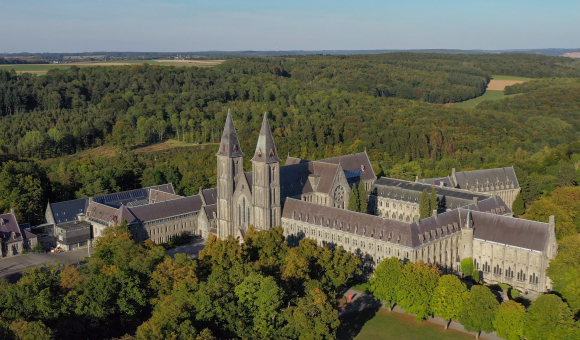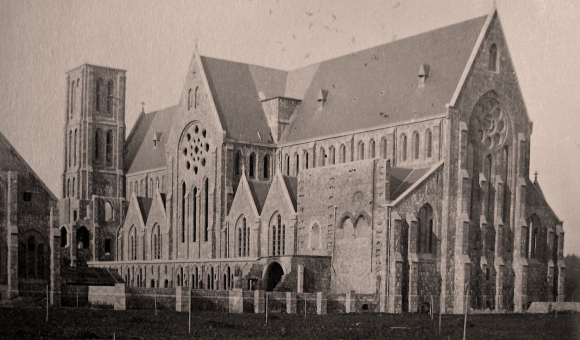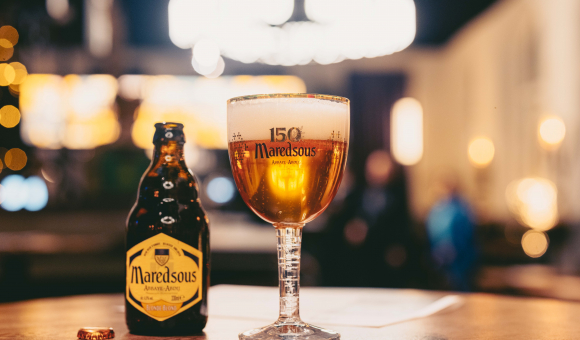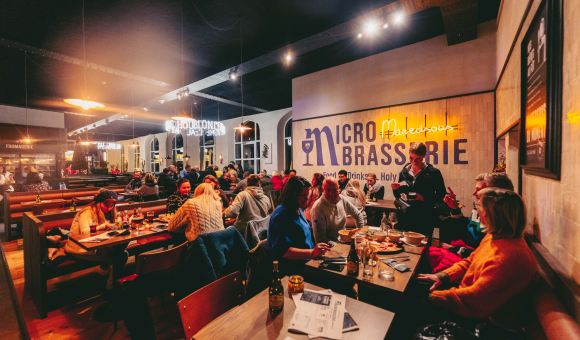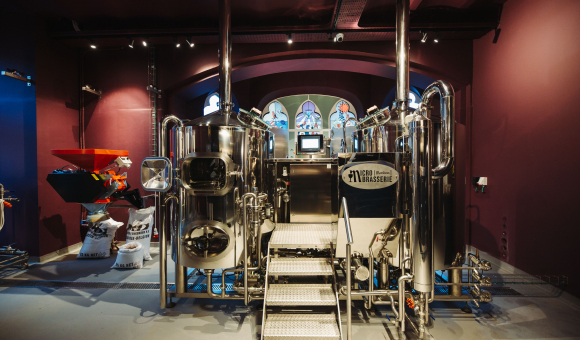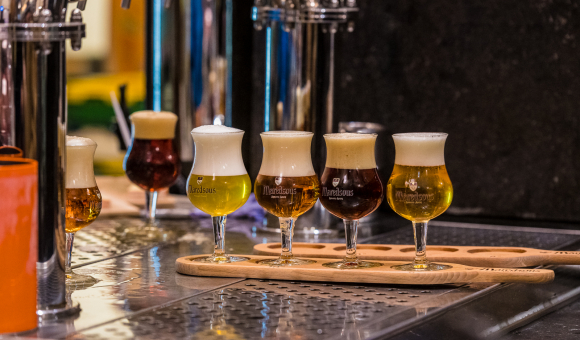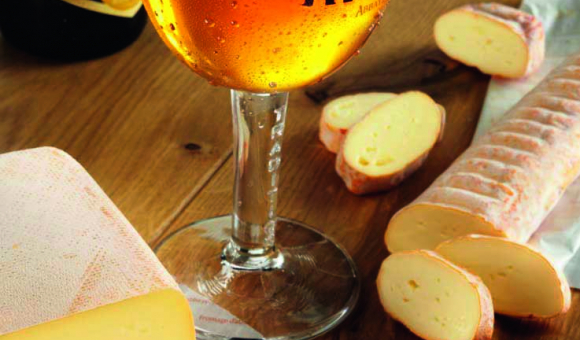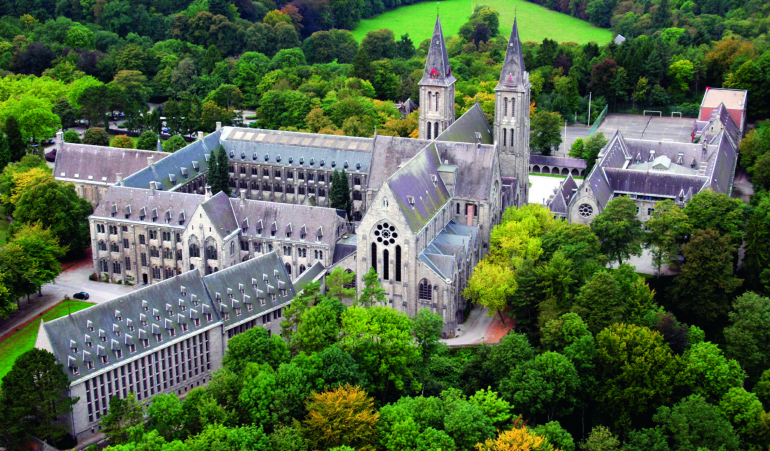
In its latest issue, Revue W+B celebrates 150 years for Maredsous Abbey!
Maredsous Abbey has just celebrated its 150th anniversary. It has succeeded in achieving the delicate balance of bringing together as many people as possible without denying its core missions. Today, it is the third most popular tourist attraction in Wallonia-Brussels and a renowned Benedictine see.
You have to leave the banks of the Meuse and climb the stubborn foothills of the Condroz in Namur to discover a region of bocages where the yellow of rapeseed stands out here and there against the fields of green grass. Everything here exudes serenity and fulfilment. A feeling of well-being that grows with every kilometre as the road plunges towards Anhée then Denée, in the pretty Molignée valley, well known for the draisines that use the tracks of the old railroad.
The plateau of Maredsous Abbey comes into view after passing a few signposts. In any case, we know why and how we come here, following in the footsteps of pilgrims and tourists who for 150 years now have found peace of mind, rest for the soul and satisfaction of taste within these austere walls of weathered granite.
Last year alone, almost 600,000 visitors enjoyed the site and its products, making it the third-largest tourist attraction in Wallonia and Brussels, far behind Walibi and Pairi Daiza, but ahead of all the others...
150 years isn't very old for an abbey. It owes everything to the Desclée family, well known for their involvement in public lighting and publishing, especially of a religious nature, together with the De Brouwer family. A "modern" abbey, all the more open to the world and in tune with the times as it follows the rule of St. Benedict.
300 workers for 20 years
When Henri-Philippe acquired the estate in 1872, the family's intention was simply to have a private chapel for Sunday mass, so they wouldn't have to attend services in the vicinity of their second home, a slightly isolated château-farm and mill slightly below the Scrapia plateau. This vast, rocky but flat landscape, on the one hand, and the Desclée family's ultramontane Catholic leanings (close to the Vatican train of thought) on the other, gave rise to the idea of a new abbey, to be built in Germany.
For 20 years, more than 300 workers - including 120 stonemasons from two nearby quarries - were needed to complete the plans drawn up by Kortrijk architect Jean-Baptiste Bethune. The latter, a fervent Catholic, is considered the "pope", so to speak, of neo-Gothic architecture in Belgium, to such an extent that he created, together with the Flemish poet Guido Gezelle, the St-Luc architectural institutes, which are still active today. It was an architectural gesture and a new religious establishment that earned the family the right to call themselves the Desclée de Maredsous.
To be honest, the four buildings (the church and cloister, the Sisters' institute, the College and the St Joseph reception centre, a former arts and crafts school) are not particularly beautiful. The buildings could even be described as somewhat austere, impressive but no more than that, in the image of a Benedictine philosophy that has made sobriety its cardinal virtue.
In 2008, a girls' dormitory was set up in the former Hôtellerie Emmaüs, at a respectable distance from the boys' dormitory... All 250 students, generally from the higher social classes, the nobility and the diplomatic corps, the majority of whom are boarders, still wear uniforms as the hallmark of an education taught by some 50 teachers and renowned for its taste in science and mathematics.
Royalties for the abbey
"Last year we decided to set up two independent guided visits," explains Bernard Torlet, the site's sales manager. One for the religious aspect, let's say, and the other somewhat more gustatory, related to the highly varied range of products made on the site, such as ceramics, bread and cheese". But no beer? "Beer is never brewed in an abbey where there's a school, because there's a law against producing alcohol in such places. What's more, our production is too large, and the Duvel-Moortgat brewery, based in Puurs, takes care of it. Our beer is brewed according to a very specific method, with some of the monks' secrets, and pays royalties to the abbey in exchange for the use of its name and logo. That said, to mark our 150th anniversary, we've installed a hop barn and a micro-brewery here, which is due to release its first beer at the end of this year."
The tour of the complex - the only one you have to pay for, as entrance, parking and access to the playground are free - always ends in the St Joseph reception building, where you don't have to beg to find what you're looking for, within the limits of wisdom of course...
In record time, no more than an hour, our knowledgeable guide Marie-Thérèse Tops, who knows the site like the back of her hand, uses her skills to make these old stones speak for themselves. Starting with a detailed description of the church portal, she reveals the abbey's symbols as milestones in its history. The interior is extremely sober since the monks decided not to restore the frescoes in the wake of the Second Vatican Council, but the height and rigour of the building are striking. There's no room here for distraction. Everything revolves around God and serving him. Moreover, there are no other sacraments such as baptisms, weddings and funerals, except for the Desclée family, and of course the monks. There's even a saint among them, Dom Columbia Marion, an Irish monk who was elected abbot of Maredsous and served from 1909 to 1923. This year marks the centenary of the death of the man proclaimed Blessed by Pope John Paul II on 3 September 2000. The annual celebration of his feast day is on 3 October, and his remains have been returned to an alcove in the church devoted to his memory. But there were no candles or votive offerings - the monks preferred to make a donation to the community.
250 people and 40 hectares
Abbot Bernard, who may be standing for a third 8-year term next year - which would be a first - is not only in charge of his 25 monks, but also of this 250-people-strong business spread out over 40 hectares, which has to be well maintained. Not to mention hundreds of thousands of tourists every year.
It's easy to see why only a few buildings, such as the church, St. Joseph's and the Little Cheese Museum are open to the general public. A guided tour lets you discover the cloister, and every now and then you get to see a monk in shorts on a hot summer's day. Normally, they cover themselves in their black habit for celebrations or contact with the public, reminding us that this is an apostolic order, not a contemplative one. This openness to the world through work and knowledge is actually one of the Benedictine monk's basic missions. In the west wing of the cloister, some seven former cells have been converted into guest rooms. They're packed all year round, as so many people come here looking for a bit of reflection and meaning in their lives or future commitments.
The monks of Maredsous are renowned for their theological research, and can boast one of the largest private libraries in Europe, holding 500,000 volumes, some of them very rare. The Maredsous Bible, a translation in accessible language and large print, is a benchmark. The bible has also been digitised, because the monks know full well that they live in the 21st century.
When they leave, they'll find themselves in the small cemetery next to the cloister. Until recently, monks would return directly to the earth, wrapped in a shroud in the fetal position, as if for the birth into a new life they had worked for down here.
Between beer and cheese
Maredsous beer was first made back in 1947, just after the Second World War. As the Abbot recounts in a neat little diary that can be found on site, "Many pilgrims took the train to Maredsous. By the time they reached the abbey, they were thirsty. A monk then suggested setting aside a small place for them. That's how Maredsous 6 came about (the number comes from its alcohol content).
In 1963, the licence was negotiated with the Duvel-Moortgat brewery under the strict supervision of the monks. Lager (6% alcohol), bitter (8%) and a triple in 1990 (10%) are part of the range, which was joined by Maredsous extra in 2017. These abbey beers enjoy an acknowledged denomination.
The local micro-brewery's beer is due for release at the end of this year, and its installation provides an opportunity to talk about the main stages in production.
To accompany this beer, the monks developed a delicious cheese in 1952, reviving ancestral maturing methods. 45 tonnes are produced each year at the abbey itself by a cheese factory employing 35 people. You can learn more about the process in the adjoining Little Museum.
A beer or soft drink, a piece of bread, some cheese and a little butter, sit back in one of the chairs on the large terraces, look up to the sky and savour the moment. It is suspended in time.
"7 to 8,000 mugs disappear every year"
There haven't been any appearances by ghosts in Maredsous. On the other hand, there are thousands of disappearances every year. What disappears is ceramic mugs stamped with the well-known logo. "We get by", admits sales manager Bernard Torlet, a touch philosophically. "We've tried everything, but I wouldn't want our staff members, more than half of whom are full-time students, to be involved in any kind of repression or take unnecessary risks."
Moving the mug should not be confused with removing it. Here too, it's all a question of how you look at it. But not everyone seems to have understood this.
By Philippe Vandenbergh
This article is taken from Revue W+B No. 160, published by Wallonie-Bruxelles International.
